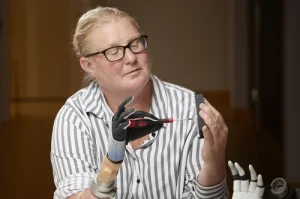
Researchers in Sweden have delivered on the promise to build life-changing bionics. A Swedish woman who lost her right hand over two decades ago in an accident has been successfully outfitted with the first bionic appendage, according to Science Robotics Journal.
The science behind the technology was described as ‘groundbreaking’ because the artificial arm appears to have fully integrated with the muscles, bones, and nerves of the patient since it was attached in 2017.
‘Karin’, the patient reported a dramatic improvement in function and a significant lessening of pain. She stated before the attachment of the bionic hand, ‘it felt like I constantly had my hand in a meat grinder’. She had two types of pain: stump pain where the amputation had occurred, and phantom pain which is commonly felt even after the limb has been amputated.
Karin said she took ‘high doses of various painkillers’ to deal with the pain. Her standard prosthetic devices were also incredibly uncomfortable, but the novel bionic hand has changed that. It was developed by a team of Swedish, Australian, Italian, and American researchers.
After the bionic hand was attached, the intensity of the phantom pain dropped from 5 to 3. Also, her stump pain dropped from a 6 to a 0. ‘Today I need much less medication’, Karin said. She added that she now had ‘better control over my prosthesis.’
Max Ortiz-Catalan, study leader, stated that poor control is one of the primary problems with standard prosthetic devices. Ortiz-Catalan is the Director of the Center for Bionics and Pain Research in Sweden, as well as the head of Neural Prosthetics Research with the Bionics Institute at St. Vincent’s Hospital in Australia.
‘There are several sophisticated prostheses but patients struggle to control all their functions in a reliable and intuitive manner,’ he noted. He added that these devices are usually painful or uncomfortable ‘because they are normally attached to the residual limb using a socket that strongly compresses the skin.’
To resolve these issues, the team decided to test the potential of a novel robotic hand device created by Prensilia, an Italian robotics company. ‘Mia Hand’, as the device was called, was designed with the objective of giving patients the ability to carry out 80% of routine day-to-day tasks. It was also developed to be aesthetically customizable to reduce the stigma people with artificial limbs face.
‘It is connected directly to the skeleton, using osseo (bone)- integrated implants,’ said Ortiz-Catalan. As time passes, the bone tissue covers the titanium in the prosthetic device, creating a strong bond between the body and the device. Ortiz-Catalan reported that the implants ‘also serve as a communication getaway between the prosthesis and electrodes implanted in nerves and muscles.’
The job of the electrodes is to collect information about localized nerve control, which is then transmitted externally to a computer that uses artificial intelligence to guide hand use.
The hand was also created with sensors which create sensory feedback between the patient’s nerves and any object the bionic hand comes in contact with. The goal is to integrate the patient’s nervous system with prosthetic electronics while improving control and reducing pain.
The bionic hand is also designed to be user-friendly. It can be easily detached and re-attached at bedtime. Ortiz-Catalan stated that Karin is the first patient to ever work with ‘this new concept of a highly integrated bionic hand.’
‘We are not near the function of a biological limb. But it is a promising testament to the potential life-changing capabilities of this novel technology for individuals facing limb loss,’ Ortiz-Catalan said.
By Marvellous Iwendi.
From UPI.